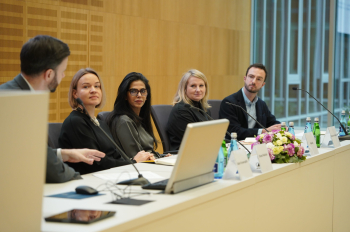
Author Kare Bluitgen, the man behind the Danish Mohammed cartoons that set off a firestorm when they were published 15 years ago Wednesday, refuses to give in and is
publishing a new illustrated Koran.
"I started this book to teach Danish young people about the second-biggest religion in Denmark, and it ended up killing more than 200 people," Bluitgen tells AFP.
In the summer of 2005, the far-left writer published an advertisement saying he was having a hard time finding an illustrator to draw the Prophet Mohammed -- whose depiction is banned by Sunni Muslims -- for a youth book he was writing on Islam's founder.
Flemming Rose, at the time the cultural editor of Denmark's big conservative daily Jyllands-Posten, took him at his word and invited Danish illustrators to draw Mohammed however they wanted.
"The newspaper wanted to see if I was lying or not when I said it was difficult for me to find an illustrator. They didn't believe me," Bluitgen recalls.
Twelve cartoonists heeded the newspaper's call, and their caricatures were published on September 30, 2005, under the heading "The Face of Mohammed".
Most of them were harmless or mocked the task itself. The most controversial ones depicted a sword-wielding bearded man in a white turban flanked by two women in niqabs, and a prophet with a bomb in his turban with a lit fuse.
"I knew there would be a few extremists, Al Qaeda especially, that would be angry. But I had no idea it would be a worldwide crisis," says Bluitgen.
He ended up not using any of the drawings for his book, but did finally find an illustrator who chose to remain anonymous.
The cartoons in Jyllands-Posten went almost unnoticed initially. After two weeks, a demonstration against them was held in Copenhagen, and then ambassadors from Muslim countries in Denmark lodged a protest.
The anger then escalated into anti-Danish violence across the Muslim world in February 2006. It culminated in a 2015 massacre that left 12 people dead at the Charlie Hebdo satirical weekly in Paris, which had reprinted the cartoons in 2012.
Last week, the suspect behind a knife attack in Paris said he also wanted to avenge Charlie Hebdo's decision to again republish the cartoons in September.
- 'No regrets' -
A number of Danes associated with the cartoons still live under police protection, like Flemming Rose who needs an escort to "be able to live the way I want."
For him, the decision to publish the cartoons was a journalistic exercise intended to illustrate the extent of self-censorship when it comes to drawing the prophet.
"Today that decision makes sense to me... I have no regrets," Rose tells AFP.
The first country in the world to abolish censorship in 1770, Denmark today tops global rankings when it comes to freedom of expression.
Anders Fogh Rasmussen, prime minister at the time the cartoons were published, refused to apologise for them even when faced with an unprecedented boycott of Danish products.
But some of the 12 cartoonists -- most of whom no longer speak publicly -- admit their attitude has changed.
"I always give it a second thought in terms of not provoking too much and being a little more subtle about my ideas," explains Bob Katzenelson, one of the few who still gives interviews.
"The cartoons affair has not been forgotten in Islamist militant circles," Denmark's intelligence agency PET wrote in a report in March.
Police have foiled several attacks against Jyllands-Posten, which ultimately apologised for offending Muslims.
And Kurt Westergaard, who drew the ticking bomb turban, saved himself from an axe-wielding attacker in 2010 by hiding out in his bathroom-turned-panic room.
As for Bluitgen, he's publishing a new illustrated Koran on the 15th anniversary.
"It's a tradition in Europe that when we have big, complicated books for children we use illustrations. We cannot give up on that," he says.
Lars Refn meanwhile continues to draw cartoons. Through the association "Cartooning for Peace" he uses humour to fight for the respect of cultures and freedoms.
"A cartoon is a nice way of keeping democracy alive," he says. AFP

















